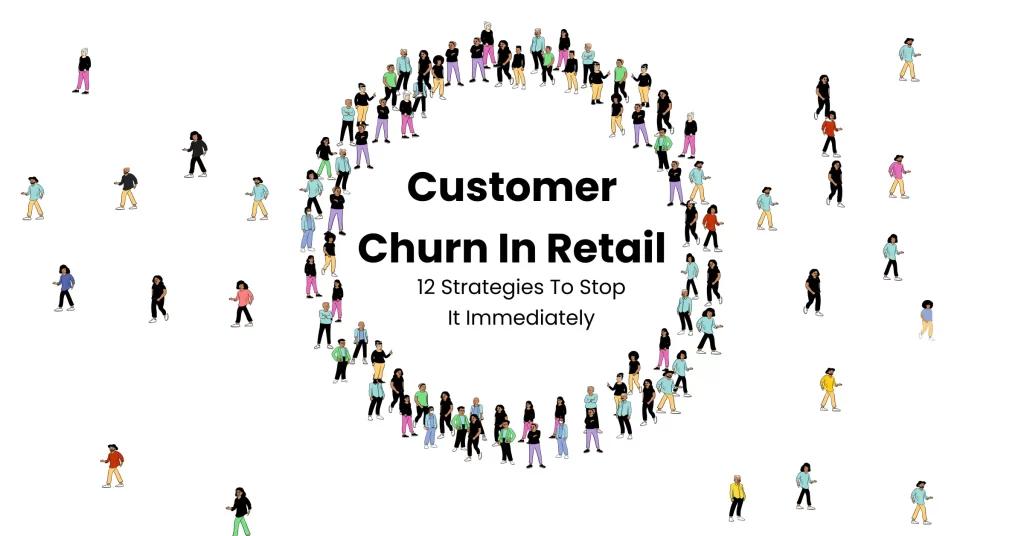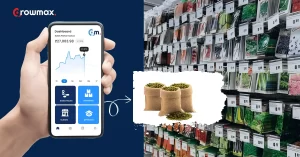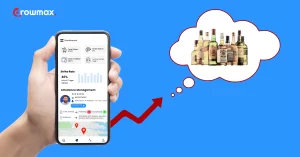Quick summary:
- When customers are unhappy with your services, they leave. This process is called customer churn.
- Companies lose $1.6 trillion every year because of customer churn.
- Many reasons cause this churn. However, the biggest reason in most cases is poor customer service.
- The churn can be calculated, predicted, and minimized if a company is willing to work seriously on it.
Losing and gaining customers is a common thing in business. However, it shouldn’t be taken lightly. When a dissatisfied customer leaves a product, the company doesn’t only lose its revenue. It loses much more. Dissatisfied customers are more likely to share negative experiences and tarnish the business’s reputation.
That is why addressing the challenge of customer churn is important for businesses, especially in retail, where the customers have a market full of options to switch. This article explores what customer churn is and dives into the solutions that solve them immediately.
What Is Customer Churn? 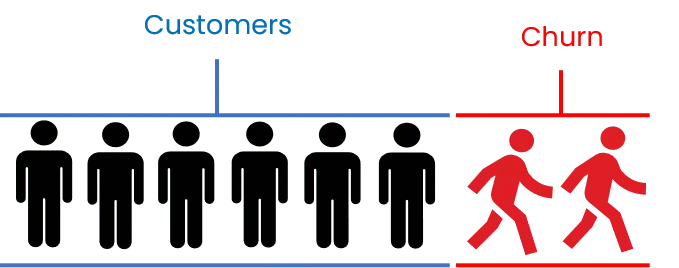
Put simply, Customer Churn is the percentage of buyers who stop buying from you over a period of time. It is a rate at which your costumes leave and never return.
For example, if your brand had 1,00,000 customers last month and only 70,000 returned this month, then the churn is 30%.
Customer churn can happen for various reasons, including high prices, poor availability, and bad shopping experiences. The core reason for all is dissatisfaction or non-fulfillment of desires.
Why Does The Churn Matter?
According to Accenture, companies lose about $1.6 trillion every year because of customer churn. And this figure is of the U.S. alone. The real number will be significantly higher and scarier.
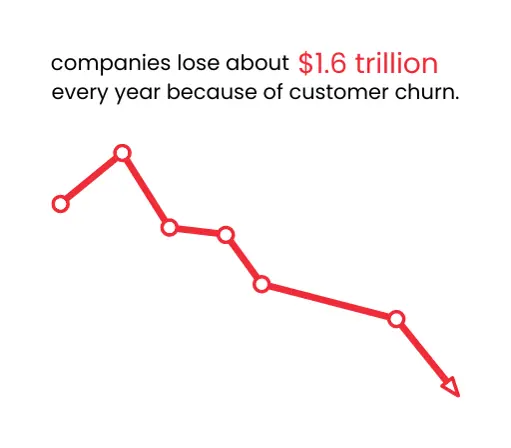
This is a huge challenge for companies, especially FMCG and CPG brands, who compete with varied competitors daily. Secondly, when we speak of profitability, retaining existing customers costs way less than acquiring new ones. As per the Harvard Business Review, acquiring a new customer is anywhere between 5 to 25 times costlier than retaining an existing one.
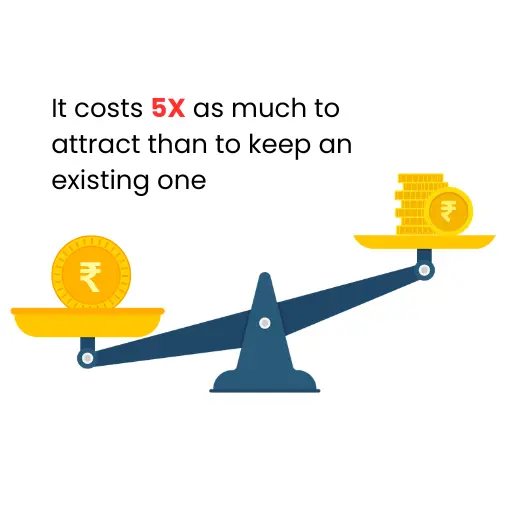
Why Do Customers Leave A Company?
In retail, customers may leave for a varied number of reasons. However, all of them can be understood by knowing the root reason: dissatisfaction.
Here is a brief table of reasons that ruin the customers’ experiences and influence them to stop buying in the future.
Churn Rate Formula
Calculating the churn rate is a simple process. Just divide the lost customers by the number of customers started with. And then, multiply the result by 100.

For example, If we started with 50,000 customers and lost 5,000 during the month. The churn rate would be 5,000 divided by 50,000 multiplied by 100. The churn rate, thus, will be 10%.
Here are churn rate benchmarks for consumer goods and retail companies
- The median churn rate for an established B2C consumer goods company is around 9.00%
- The median churn rate for a company dealing in products at a price lower than $10 is 3.53%
- The same for a company dealing in products priced higher than $250 is 7.14%
- For the products with prices between $10-250, the churn rate may vary from 4.09% to 5.60% (Source)
12 Strategies To Minimize Customer Churn In Retail:
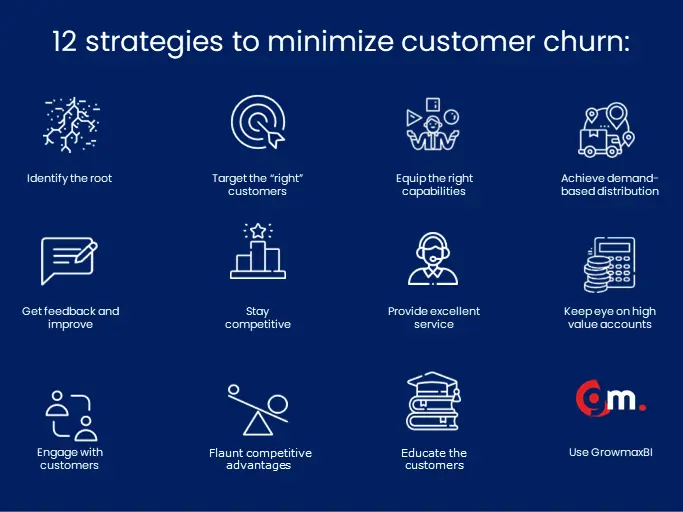
1. Identify the root of the churn
The customers of Consumer Goods Companies have a variety of options to choose from. When a particular product is unavailable, inaccessible, or fails to satisfy them, they immediately move to its next alternative.
Therefore, the firms must focus on understanding the root of the customer churn and fix it using their resources. Cutting the roots will immediately cause the tree to fall. The roots are the unavailability of customer insights, market visibility, and distribution control that cause other visible problems like spoiled or unavailable stocks.
2. Target the “right” customers
Every business loses and gains customers regularly. The customers who find the product valuable remain, and the ones who land by accident leave.
How do these “didn’t need it but bought it” customers come? By wrong targeting. When companies focus solely on reaching new faces without filtering for the ones they care about, they prepare for future customer churn.
Therefore, companies should focus on attracting and serving the “right customers” initially. The right customers are the ones that are properly segmented based on their desires, demographics, psychographics, and financial conditions.
3. Equip the right capabilities before it’s too late
Retail markets are full of competition. Every player is trying their best to get ahead of others. Among these, the player with the most successful decisions will win. But what makes a successful decision successful?
As we see from analyzing the past decade, technology-driven insights are what businesses need. Today’s markets and supply chains have gotten webbed to a point where managing them with human capabilities is impossible. Therefore, successful companies opt for real-time automation tools that simplify this mess and improve management.
4. Achieve demand-based distribution
Product unavailability forces people to switch brands. But why does this happen despite taking great care of the supply chains and spending billions on distribution?
It is because the very nature of retail distribution is ‘fragmentation .’Some areas get more stock than needed, and some don’t get anything at all. If somehow the consistency is maintained, then the delivery is delayed.
The traditional methods are imperfect. Therefore, companies must adopt new ways to gain real-time demand insights and fulfill them accordingly. The aim should be for zero stockouts and zero product spoilage.
5. Ask for feedback and tweak the products if needed
Buyers of different geographies have different tastes and preferences. One product cannot satisfy everyone.
Case Study:
Revlon, a company selling camellia-scented perfume in the U.S., tried to enter the Brazilian market. However, they didn’t realize that camellia flowers were used in funerals in Brazil. As a result, their perfume was a total failure.
Therefore, companies should continuously collect market feedback and optimize their operations and products to best fit the market. GrowmaxBI helps you do it using the salesman app’s market survey feature.
Therefore, companies should continuously collect market feedback and optimize their operations and products to best fit the market. GrowmaxBI helps you do it using the salesman app’s market survey feature.
6. Stay competitive
Other than product unavailability, the next big reason customers leave a product is “alternatives .”They find another product that solves the problem better, cheaper, or more uniquely.
Thus, companies should always keep themselves competitive and offer customers the best products in price, segment, or geography.
7. Provide excellent customer service
In many cases, it is not the product but the customer service. How confident does a customer feel returning your product or sending a complaint? Is the process complicated or incomplete?
Greasing the customer service department instantly puts you among the best companies out there for a customer.
8. Keep an eye on high-value accounts
There will always be some customers leaving your brand. It is inevitable, and you cannot retain them all. Therefore, sort the list of the highest-value accounts and maintain real-time visibility. Focus the resources and efforts on retaining them before anyone.
How could it be done in retail? By using a sales force automation solution. An SFA solution lets companies track their sales and customer accounts in real-time. It helps redirect the focus toward the work areas with the highest ROI.
9.Engage with customers
Engaging with customers is a critical part of any customer retention strategy. Human beings are prone to forgetfulness. Therefore, effective brands keep reminding their customers about their products and their brand via ads and paid partnerships.
However, the best way to do this is by genuinely engaging with the customers where they hang out. For example, many successful consumer goods companies engage with their customers on Instagram and build strong relationships.
10. Flaunt competitive advantages
Simply delivering high-quality products in today’s market is not enough. Companies must regularly remind customers why they are best at what they do. Businesses need to remind their customers of their unique strengths that the competitors do not or cannot have.
Doing so will help companies differentiate themselves from the crowd, build customer loyalty, and reduce the likelihood of customer churn.
11. Educate the customers
If the general public does not understand the value of your product, teach them. Make them understand the value you provide with targeted messages like billboards, usage guides, or descriptive graphics on the back of the packaging.
Customer churn goes significantly low when customers utilize the product’s full potential.
12. Use GrowmaxBI to nail operational excellence
Optimizing the operations alone can solve many issues that contribute to customer churn. For example, a consumer goods company that never fails to deliver the right products at the right time on the right shelves will lose far too few customers than an ordinary company.
It further establishes data-driven systems to calculate sales trends, track fulfillment, and determine why customers leave.
